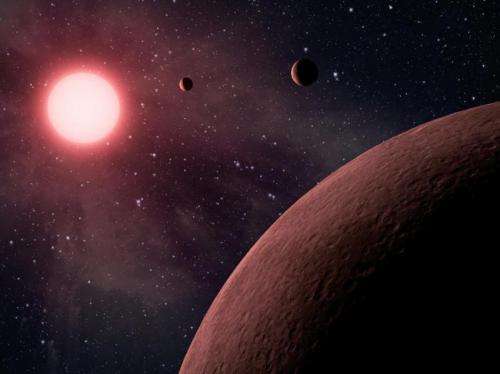December 12, 2014 report
NASA scientist offers perspective on the factors that may lead to life on a planet

(Phys.org)—NASA space scientist Pamela Conrad has offered a Perspective piece in the journal Science, reminding readers that the search for life on planets such as Mars, isn't limited to just looking for water. Instead, she notes, most researchers believe that a combination of events must occur, likely simultaneously for life to get a start and then to be maintained.
Conrad notes that a lot of the press regarding the study of Mars by scientists with NASA and other groups, tends to focus on the search for water, or evidence that water was once there—with the implication that if it was, then surely evidence will be found that life was there too. But that is not really the case, she asserts—there are likely a whole host of factors that must all be there for life to have been possible.
Some of those factors might include a global magnetic field (likely produced by an internal dynamo) which would shield the planet from ionizing radiation. Another would be temperature and its variations—too hot or too cold for only part of any given period would likely prevent life from taking hold. Wind might also play a factor—she notes that as life is first starting, it's not likely very mobile, thus wind that would carry essential material such as iron deposits to replenish supplies exhausted by new life forms would be essential. There is also the matter of an atmosphere—having one offers a shield against ultraviolet radiation and also serves as a cloak, moderating temperatures.
But such factors, she continues, are much more difficult to find than water. Scientists are reasonably sure that Mars once had an atmosphere and global magnetic field—it's more difficult to pin down whether they were existent at the same time, and if so, if temperatures were in a range during that period that would have allowed life to come about.
Conrad notes that missions to Mars are proving fruitful regardless of whether proof of life is found or not. Such missions, she maintains are allowing us humans to learn more about how life could come about, which could prove useful once we're able to study more distant planets more carefully—and that includes a manned mission, which should allow researchers, she believes, to do the kind of impromptu research that most often leads to breakthroughs.
More information: Scratching the surface of martian habitability, Science 12 December 2014: Vol. 346 no. 6215 pp. 1288-1289, DOI: 10.1126/science.1259943
Abstract
Earth and Mars, though formed at the same time from the same materials, look very different today. Early in their histories they evolved through some of the same processes, but at some point their evolutionary paths diverged, sending them in perhaps irrevocably different directions. Knowledge of the factors that contributed to such different outcomes will help to determine how planets become habitable and how common habitable planets may be. The Mars surface environment is harsh today, but in situ measurements of ancient sedimentary rock by Mars Science Laboratory reveal chemical and mineralogical evidence of past conditions that might have been more favorable for life to exist. But chemistry is only part of what is required to make an environment habitable. Physical conditions constrain the chemical reactions that underlie life processes; the chemical and physical characteristics that make planets habitable are thus entangled.
Journal information: Science
© 2014 Phys.org





















